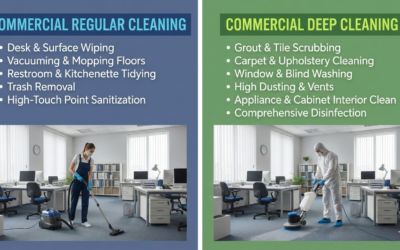If you’ve spotted those dark specks creeping along the sill or smelled that damp, earthy odor each time you draw the curtains, you’re already wondering how to clean mold from windows. Black mold and its cousin, mildew, thrive on condensation, wood frames, and forgotten corners—but with the right approach, you can erase the stains, stop the spores, and breathe easier in a single afternoon.
Why Mold Loves Your Windows
Before you learn how to clean mold from windows, it’s useful to know why the fungus shows up at all. Glass is inert, but the surrounding caulk, paint, and timber sills hold onto moisture. Add poor ventilation, a chilly pane that causes condensation, and a dash of neglected dust—that’s prime habitat for mold spores to bloom. In colder climates, condensation forms overnight; in humid zones, it happens year-round. Either way, the cycle repeats until mold removal becomes an urgent chore.
Gear Up: Safety First
When you’re figuring out how to clean mold from windows, always start with safety. Mold remover ads tend to skip this part, yet inhaling spores can trigger allergies and asthma. Suit up with basic safety gear: rubber gloves, an N95 mask, and wraparound goggles. Keep a spray bottle of white vinegar, a small container of baking soda, a bleach solution (1 cup bleach to 1 gallon water) for stubborn black mold, and a stiff cleaning brush or non-scratch scrubber. Crack open nearby windows or switch on an exhaust fan so you’re not working in a cloud of spores or bleach fumes.
Your Mold-Fighting Toolkit
The toolkit for how to clean mold from windows is surprisingly simple and cheap:
- White vinegar: a natural mold killer that breaks down mildew without toxic residue.
- Baking soda: gentle abrasive plus deodorizer—ideal for wood frames and vinyl sills.
- Bleach solution: the nuclear option for entrenched fungus and black mold staining.
- Borax or hydrogen peroxide: optional upgrades for heavy infestations.
- Microfiber cloths & old toothbrush: reach tight corners between frame and glass.
- Spray bottle, bucket, and cleaning brush: control coverage, avoid drips.
Step-by-Step Cleaning—Phase One: Vinegar Pass
Step 1 of how to clean mold from windows is to open the window for airflow and lay an old towel on the floor. Mist white vinegar generously over all contaminated areas—vinyl tracks, caulking, even the glazing bead. Let it sit for 60 minutes; vinegar needs dwell time to penetrate mold roots. Meanwhile, use a dry cloth to wipe loose debris so the acid can contact stubborn spores directly. After the hour, scrub the surface with a nylon brush, rinse with warm water, and pat dry.
Phase Two: Bleach Backup
Step 2 in how to clean mold from windows switches from white vinegar to a mild bleach solution for spots that refuse to budge. Dip the brush, squeeze off excess to avoid splatter, and work the bleach into stains on wood frames or silicone seals. Keep the area wet for 10 minutes; bleach disinfects only while it’s moist. Rinse thoroughly and wipe dry. If you can still see gray shadows, repeat once more or move on to hydrogen-peroxide gel for color-safe stain lifting.
Phase Three: Wood-Frame TLC
If you’re dealing with wood frames, how to clean mold from windows means treating the grain, not just the surface. Create a paste of baking soda and water, spread a thin layer over any discoloration, and let it draw out moisture for 15 minutes. Scrub lightly with a toothbrush following the grain to avoid scratches, then wipe with a damp cloth. Finish by applying a thin coat of mold-resistant primer or clear sealant after the wood dries completely; this blocks future fungi from colonizing tiny pores.

Keep Mold from Coming Back
Long-term success with how to clean mold from windows comes from stopping moisture in its tracks. Run a dehumidifier in damp rooms to keep relative humidity below 50 percent. Install weatherstripping so warm, moist indoor air can’t meet a cold pane and condense. Use an exhaust fan while cooking or showering, and crack windows for cross-ventilation on mild days. Consider insulated double-glazed glass or thermal curtains to reduce temperature swings that feed condensation.
Frequently Asked Questions
Q1. Can I really kill mold with nothing but white vinegar?
Yes—straight white vinegar (5–6 % acetic acid) kills up to 82 % of mold spores on first contact. Mist the affected sill, track, or window frame, let it dwell for at least 60 minutes, then scrub with a nylon cleaning brush. For stubborn black mold, follow up with a mild bleach solution or hydrogen-peroxide gel to erase any lingering stains.
Q2. Is bleach safe for vinyl or aluminum windows?
A diluted bleach mix (1 cup bleach to 1 gallon of water) is generally safe for factory-finished vinyl and powder-coated aluminum as long as you rinse thoroughly and never let the liquid sit for more than 10 minutes. Always wear rubber gloves, an N95 mask, and keep an exhaust fan running to vent chlorine fumes.
Q3. How often should I inspect my windows for mold or mildew?
In humid zones or during rainy seasons, do a quick inspection every month. Look for condensation on the pane, dirt in the drain holes, and discoloration on the caulk. A 60-second wipe-down with a microfiber cloth will stop colonies before they root.
Q4. What’s the best way to clean mold from wooden window sills without damaging the finish?
Mix baking soda with a little water to form a spreadable paste. Work it along the grain with an old toothbrush, then wipe with a damp microfiber cloth. This lifts the fungus and deodorizes without stripping varnish. Once dry, seal the timber with a mold-resistant polyurethane or wax to block future moisture.
Q5. Can mold grow between double-pane or triple-pane glass?
Unfortunately, yes—if the factory seal fails, warm indoor air meets the cool cavity and feeds mold and mildew inside the spacer gap. Because the space is airtight, DIY cleaning rarely works; you’ll need a window-repair service to replace the insulated glass unit.
Q6. Will a dehumidifier really stop window mold from coming back?
Absolutely. Mold loves relative humidity above 50 %. A small room dehumidifier paired with good ventilation (open trickle vents or run ceiling fans) keeps moisture low enough that mold spores stay dormant. For bathrooms and kitchens, add an automatic exhaust fan with a 15-minute timer to clear shower or cooking steam.
Q7. Are natural essential-oil cleaners as effective as commercial mold removers?
Tea-tree oil and grapefruit-seed extracts have mild antifungal properties, but they work more slowly than vinegar or peroxide. They’re fine for light surface cleaning, yet heavy fungus infestations along silicone seals or window tracks respond better to stronger acids or oxidizers.
Feel free to drop any other questions you have about safe mold-removal techniques or long-term condensation control, and keep those sills sparkling year-round!
Wrapping Up
In short, how to clean mold from windows is less about brute force and more about patience, proper dwell time, and good airflow. Repeat how to clean mold from windows each season if your home sits in a humid zone. Make a phone reminder titled how to clean mold from windows for the first Saturday of spring and share this guide on how to clean mold from windows with a neighbor who’s sneezing already. When you master how to clean mold from windows, you protect your home, your indoor air quality, and—perhaps best of all—your peace of mind.
Ready for Mold-Free, Crystal-Clear Windows?
At MCA Group in North York, ON, we don’t just clean—we care. Whether it’s routine window cleaning, mold removal, or deep track detailing, our expert team ensures every pane and frame is spotless, safe, and streak-free. Don’t let mold compromise your indoor air or your view.
👉 Book your professional window cleaning service today and enjoy a healthier, brighter home—inside and out!
📞 Call us now or 📅 schedule online for a free estimate and learn how to clean mold from windows!





